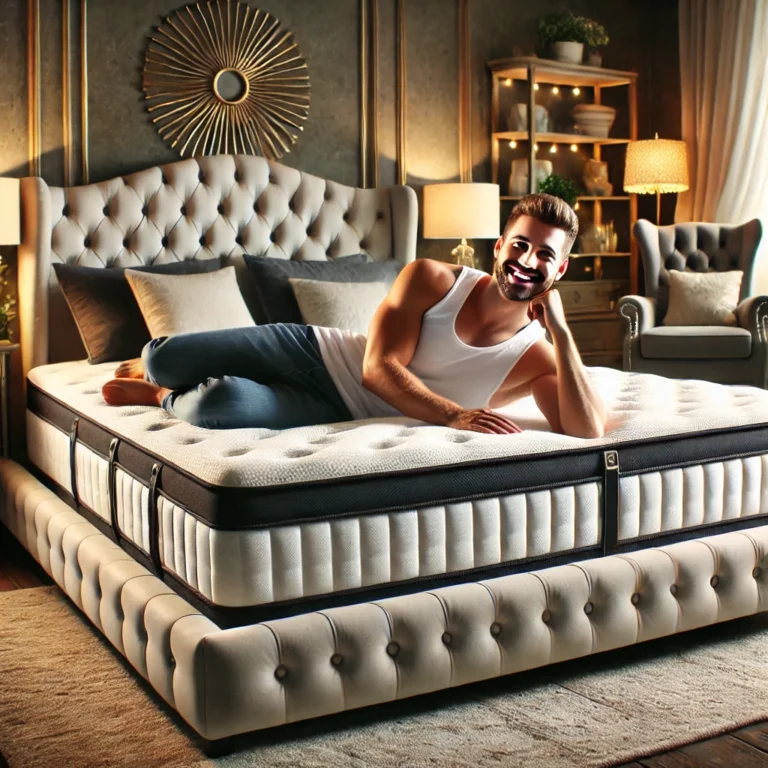Foam Mattress vs. Spring Mattress – Side-by-Side Comparison
To help you make an informed choice, here’s a detailed comparison of foam and spring mattresses across key factors like support, comfort, temperature control, durability, and more.

- Comfort and Feel:
- Foam: Offers a soft, body-hugging feel that conforms to your shape, creating a “cradling” effect. This can relieve pressure points and promote a feeling of deep relaxation.
- Spring: Provides a responsive, bouncy feel that keeps you lifted “on top” of the mattress rather than “in” it. It’s less contouring and feels firmer compared to foam.
- Winner: It depends on personal preference. Foam is best for a soft, hugging feel, while spring is ideal for a bouncier, firmer feel.
2. Support and Spinal Alignment
- Foam: Memory foam offers contouring support, which is beneficial for side sleepers, as it can cushion shoulders and hips. However, foam mattresses may lack adequate support for heavier sleepers, causing sagging over time.
- Spring: Spring mattresses provide a firm, supportive base that keeps the spine aligned, making them ideal for back and stomach sleepers who need more support to avoid sinking.
- Winner: Spring, as it offers better long-term support for a wider range of body types, especially for back and stomach sleepers.
3. Pressure Relief
- Foam: Memory foam and latex foam are especially good at relieving pressure, making them suitable for those with joint or back pain. Foam distributes weight evenly and cushions pressure points effectively.
- Spring: Spring mattresses provide moderate pressure relief, but they generally don’t conform as closely to the body, which can lead to discomfort for side sleepers or those with joint pain.
- Winner: Foam, due to its superior pressure-relieving properties, especially for side sleepers and those with aches and pains.
4. Temperature Control
- Foam: Traditional memory foam tends to trap heat, which can be uncomfortable for hot sleepers. Many foam mattresses now include cooling technologies like gel infusions or open-cell structures, but they may still sleep warmer than springs.
- Spring: The coil structure allows for excellent airflow, making spring mattresses naturally cooler than foam. This makes them a better option for people who tend to sleep hot.
- Winner: Spring, as it allows for better airflow and cooling compared to foam.
5. Motion Isolation
- Foam: Foam mattresses excel at isolating motion, making them a great option for couples or light sleepers who don’t want to be disturbed by their partner’s movements.
- Spring: Unless it has pocketed coils, a spring mattress can transfer motion across the bed, making it less ideal for couples or those sensitive to movement.
- Winner: Foam, as it significantly reduces motion transfer, making it ideal for couples.
6. Edge Support
- Foam: Foam mattresses typically lack strong edge support, which can lead to sagging around the edges. This reduces usable surface area and may be uncomfortable if you like to sleep near the edge.
- Spring: Spring mattresses generally have reinforced edges, especially models with continuous or pocketed coils. This makes the edges more stable and supportive.
- Winner: Spring, due to its stronger edge support, which increases usable mattress area.
7. Durability and Longevity
- Foam: High-quality memory foam and latex foam mattresses can be durable, lasting 7-10 years or more. However, lower-density foams can break down more quickly, leading to sagging and reduced support over time.
- Spring: Innerspring mattresses, especially those with high-quality coils, tend to be more durable than low-density foam mattresses. However, springs may start to squeak or lose tension over time.
- Winner: Tie, as both types can be durable depending on quality. High-quality foams and coils provide longevity, but low-end versions of either type may wear out quickly.
8. Price Range
- Foam: Foam mattresses, particularly memory foam, have become more affordable, with a variety of options across all budgets. Basic memory foam models are generally less expensive than hybrids or high-end spring mattresses.
- Spring: Spring mattresses can be quite affordable, but prices vary widely based on coil quality and comfort layers. Budget-friendly innersprings are widely available, while premium models may cost more than foam.
- Winner: Foam, as it offers more budget-friendly options for quality mattresses.
Pros and Cons Recap
Here’s a summary of the advantages and disadvantages of foam and spring mattresses:
Feature
- Foam Mattress
- Spring Mattress
Pros
- Foam: Excellent pressure relief, motion isolation, quiet
- Spring: Good support, cooling, affordable, durable
Cons
- Foam: Heat retention, weaker edge support
- Spring: Limited pressure relief, less motion isolation
Ideal For
- Foam: Side sleepers, couples, people with joint pain
- Spring: Back and stomach sleepers, hot sleepers, budget shoppers
Who Should Choose a Foam Mattress?
Foam mattresses are ideal for:
- Side Sleepers: The contouring of foam helps cushion pressure points like shoulders and hips.
- Couples: Foam’s motion isolation minimizes disturbances from partner movements.
- People with Joint Pain: Memory foam’s contouring and support relieve pressure on sensitive areas.
- Budget-Conscious Shoppers: Foam mattresses, especially memory foam, have a variety of affordable options.
Who Should Choose a Spring Mattress?
Spring mattresses are best suited for:
- Back and Stomach Sleepers: The support of coils helps keep the spine aligned without excessive sinking.
- Hot Sleepers: The natural airflow through coils prevents overheating.
- People Who Like a Firm, Bouncy Feel: Springs offer a traditional, responsive feel that some people prefer.
- Those Needing Strong Edge Support: Spring mattresses typically have better edge support, maximizing usable sleep surface.
Final Thoughts: Foam or Spring?
Choosing between a foam and spring mattress depends on personal preference, sleep position, and comfort needs. Foam offers contouring, pressure relief, and motion isolation, while spring mattresses provide firm support, cooling airflow, and a traditional feel. Consider your sleep style, temperature needs, and budget to decide which type best enhances your sleep quality.
Many mattress companies offer sleep trials, allowing you to ensure your choice fits perfectly. Happy shopping!





